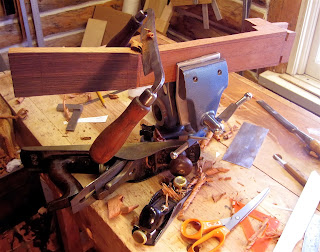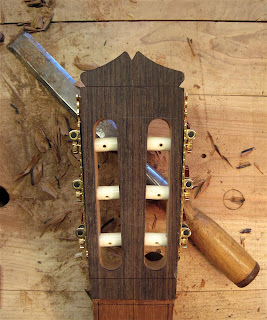When Things Go Wrong-Fixing Holes in a Classical Guitar Headstock
Measure twice, cut once, but make sure you cut on the correct line.
Merle Burnham, my father, 1976
This is a neck for a copy of a 1929 Santos Hernandez guitar, it's all glued up from heel block to head stock. In this photo I am adjusted the sides of the neck with a draw knife so I can carefully plane the sides of the head stock perfectly square so the tuning machines can have some where to sit.
What happened next is that I drilled all six holes in the head stock only to find out that I had laid out the positions for the holes using the wrong reference line. Whoops!
Spanish cedar is getting scarce, I bought this blank from Stew-Mac just before they stopped selling Spanish cedar neck blanks. I didn't want to throw it into the wood stove, I owe it to the Universe to persevere and use this neck.
With my trusty knife, block plane, Porter Cable 14 volt drill and a 13/32 inch hole drilled into a piece of bubinga, I made three dowels from a scrap piece of Spanish cedar. Some fish glue from Lee Valley and a few taps with a live oak mallet and things are as right as rain again!
Yes, you can see the plugs, but when you a play a classic guitar you are watching your hands, not the headstock! This will not affect the sound quality of a guitar.
The tuning machine's plate cover the plugs! Don't they look great!
The headstock carved and slotted.
Now, to finish carving the heel!
Merle Burnham, my father, 1976
This is a neck for a copy of a 1929 Santos Hernandez guitar, it's all glued up from heel block to head stock. In this photo I am adjusted the sides of the neck with a draw knife so I can carefully plane the sides of the head stock perfectly square so the tuning machines can have some where to sit.
What happened next is that I drilled all six holes in the head stock only to find out that I had laid out the positions for the holes using the wrong reference line. Whoops!
Spanish cedar is getting scarce, I bought this blank from Stew-Mac just before they stopped selling Spanish cedar neck blanks. I didn't want to throw it into the wood stove, I owe it to the Universe to persevere and use this neck.
With my trusty knife, block plane, Porter Cable 14 volt drill and a 13/32 inch hole drilled into a piece of bubinga, I made three dowels from a scrap piece of Spanish cedar. Some fish glue from Lee Valley and a few taps with a live oak mallet and things are as right as rain again!
Yes, you can see the plugs, but when you a play a classic guitar you are watching your hands, not the headstock! This will not affect the sound quality of a guitar.
The tuning machine's plate cover the plugs! Don't they look great!
The headstock carved and slotted.
Now, to finish carving the heel!







Comments
Post a Comment